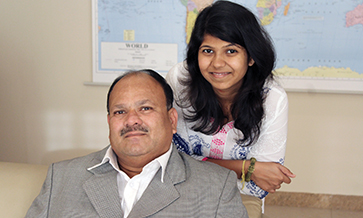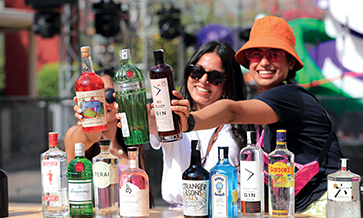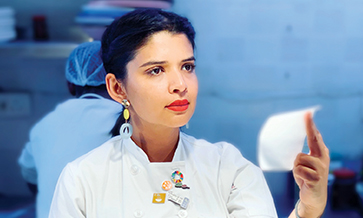Excerpts from the panel discussion during ‘Brews&Spirits Expo’ in Bengaluru, 13-15 September, 2023

Nagpal (moderator to audience): How many of you drink wine at least once a week? OK, that’s at least 50%. How many of you drink more than once a week? OK, it’s almost the same hands. Fantastic! So I think we have a nice wine audience over here. Let’s start with the Indian wine producer on the table and the head of business for Big Banyan wines.
Aeisha: The thing is that the new trend in the wine industry is RTDs, which are also wine based. That is now starting to take over the overall wine segment. RTDs are a stepping stone for people to move forward with semi-premium wines and then further on to premium and international wines as well.
Nagpal: When we talk about Indian wine companies, they are well known within the country. But we’re not yet there on the global map. When do you see this moving forward?
Aeisha: Like I said, we’re getting there. We launched a brand called L’Angoor, which is in the ?300 price segment. In a year, we saw 100% growth in Karnataka. So that movement is happening. There are a lot of youngsters, college-going kids, that are starting to drink semi-premium wines. Hopefully, they’ll move on to the more expensive premium reserve wines.
Nagpal: Aslam, you’ve worked very closely with the hotels, the 5-star hotels particularly. They don’t necessarily make the effort to beat the drum about Indian wines, whether it is in the form of activations or listings. Perhaps there are some insights that you may have?
Aslam: It doesn’t help that wine education is where we are lacking. I’ve been part of the wine club earlier, and I know people doing some great work. I think if there is a fair amount of education that goes to the younger audience, that will be a big game changer. When you want to order wine, it can get intimidating for many newcomers: Do you want a white or red? Do you prefer this grape variety, or would you want to try that? Somebody will say, ‘You didn’t hold the glass properly’, or another will say, ‘The temperature is not correct’. Somebody who’s not used to it will finally say: ‘Just get me a whiskey or a gin!’
Nagpal: Since you mentioned that you dine out a lot, you drink wines a lot, would you still pick an Indian wine over an imported one?
Aslam: Indian wines have definitely come up, but clearly the variety of brands is very, very minimal. I would prefer an Indian wine because it could be more reasonable compared to some of the better-known international wines. When it comes to the hotel, the prices of the wines are almost the same. But if you open a menu at any restaurant or hotel, the choices are very, very limited. They’re not beating the drum for Indian wines.
Aeisha: We have our winery (Big Banyan) off Mysuru Road. Over the last 2 years, we’ve seen more than 200 people coming in on Saturdays and Sundays. Unfortunately, we cant accommodate more people. But if we had a platform for all the wineries to come together and create a cool buzz around wines, I think it would be good.
Nagpal: Vishal Kadakia, you ventured into the Indian wine space early and probably thought the Indian wine moment had come. Tell us about your experience with wines.
Vishal: I think many people in the industry are doing a wonderful job – but the point is that there are not enough. If you look at the South, there are 2,500 wine producers there. We in India are probably 70. Doing to a wine culture is like a revolution; it will happen by adopting multiple methods.
Nagpal: Alex, regarding India, when will the wine moment come?
Alexander: Price is something that has come up a lot in discussions today. I think education is the most important thing. It’s not different from some of the hurdles that we have come across in other countries.
Post Covid-19 a lot of the power has gone to the employee. How do you keep them with you? You educate them, you get them involved in your vision, you fund their education – because it’s your staff that’s going to get people into wine, or spirits, or beer. They play a really important role.
There is incredible Bordeaux wine out there, but there is also incredible wine from around the world. You have great quality wine in Greece, in Spain, in New Zealand, and you just need to educate people to see that.
Nagpal: Do you see Indian consumers valuing Indian wine? Do you see that in your interactions?
Alexander: It’s tricky! I think some of the others on this panel will be able to answer better. The people I see in India are people coming to learn about wine; they come to WSET because they want to get a global perspective. They come to us because they want to have that exposure to the complexity of the global market. But that doesn’t necessarily mean that they don’t appreciate Indian wine. I think quite to the contrary.
Aeisha: In the last 10 years, Indian wines have come a long way. Quality is improving year on year. Because we have a lot to do in terms of vineyards and improving the quality of grapes. There are so many more new consumers in the market drinking the semi-premium stuff. They probably don’t understand quality just yet, but their education is important. These people are going to be the future ambassadors for Indian wines.
Aslam: There is this philosophy that people want to drink because they want to get high. Wine doesn’t provide that. In Nashik and Bengaluru, we are very fortunate to have brands that are promoting wine tourism. The Sula winery in Nashik is a tourist attraction. There are busloads of visitors with babies in their arms – that’s the audience that we need to tap! If we keep on educating that audience, when they go to a restaurant, they will ask for something that they’re familiar with.
Nagpal: What about wines in cans?
Aslam: Wine in a can will sound blasphemous to many; but I think it’s a great idea! My only worry with the wine-in-a-can concept in India is that it is so expensive. I should be able to go to a supermarket or some wine store and just pick two cans. I don’t want to buy the whole bottle, because if I buy a bottle, I need to worry about storage.
The entire wine can business in the world is US$250 million today; and it is estimated to become US$500 million by 2028. There are only six players in the entire world, Sula being one of them, who are actually leading the way for wine in cans. Mostly sold in retail, there is no HoReCa presence; and 80% of it is sparkling wine. That way you have a much wider reach.
Alexander: I wanted to pick up some cans as well because it’s really interesting now. But cans have a challenge, as everyone knows. They have to use slightly different cans because of the high acidity of wine, and they have to line it with a particular epoxy, which deteriorates after six months.
But what’s really good about it is the immediacy of cans, which you can pick up going to a cricket match, going to an event, going home on the train. It’s like how you convert a beer person into a wine lover!
(For the full recording of this panel discussion, look up the YouTube channel of Brews&Spirits Expo).













